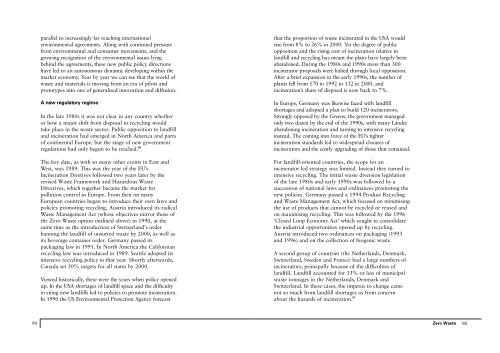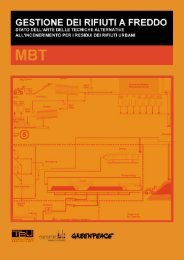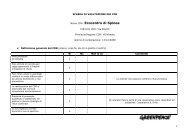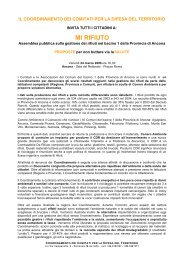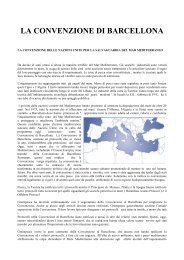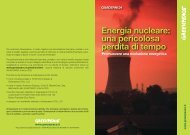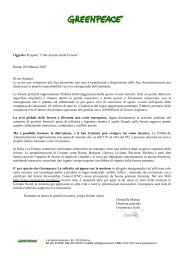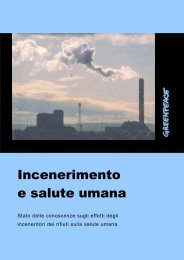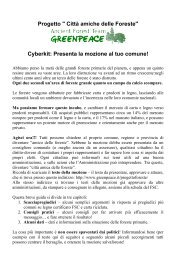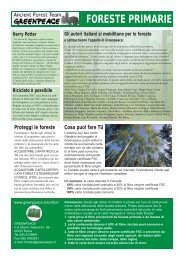Zero Waste by Robin Murray, Greenpeace Environmental Trust 2002
Zero Waste by Robin Murray, Greenpeace Environmental Trust 2002
Zero Waste by Robin Murray, Greenpeace Environmental Trust 2002
Create successful ePaper yourself
Turn your PDF publications into a flip-book with our unique Google optimized e-Paper software.
parallel to increasingly far reaching intern a t i o n a l<br />
e n v i ronmental agreements. Along with continued pre s s u re<br />
f rom environmental and consumer movements, and the<br />
g rowing recognition of the environmental issues lying<br />
behind the agreements, these new public policy dire c t i o n s<br />
have led to an autonomous dynamic developing within the<br />
market economy. Year <strong>by</strong> year we can see that the world of<br />
waste and materials is moving from an era of pilots and<br />
p rototypes into one of generalised innovation and diffusion.<br />
A new regulatory regime<br />
In the late 1980s it was not clear in any country whether<br />
or how a major shift from disposal to recycling would<br />
take place in the waste sector. Public opposition to landfill<br />
and incineration had emerged in North America and parts<br />
of continental Europe, but the stage of new government<br />
regulations had only begun to be reached. 56<br />
The key date, as with so many other events in East and<br />
West, was 1989. This was the year of the EU’s<br />
Incineration Diretives followed two years later <strong>by</strong> the<br />
revised <strong>Waste</strong> Framework and Hazardous <strong>Waste</strong><br />
Directives, which together became the marker for<br />
pollution control in Europe. From then on many<br />
European countries began to introduce their own laws and<br />
policies promoting recycling. Austria introduced its radical<br />
<strong>Waste</strong> Management Act (whose objectives mirror those of<br />
the <strong>Zero</strong> <strong>Waste</strong> option outlined above) in 1990, at the<br />
same time as the introduction of Switzerland’s order<br />
banning the landfill of unsorted waste <strong>by</strong> 2000, as well as<br />
its beverage container order. Germany passed its<br />
packaging law in 1991. In North America the Californian<br />
recycling law was introduced in 1989. Seattle adopted its<br />
intensive recycling policy in that year. Shortly afterwards,<br />
Canada set 50% targets for all states <strong>by</strong> 2000.<br />
Viewed historically, these were the years when policy opened<br />
up. In the USA shortages of landfill space and the diff i c u l t y<br />
in siting new landfills led to policies to promote incineration.<br />
In 1990 the US <strong>Environmental</strong> Protection Agency fore c a s t<br />
that the pro p o rtion of waste incinerated in the USA would<br />
rise from 8% to 26% in 2000. Yet the degree of public<br />
opposition and the rising cost of incineration relative to<br />
landfill and recycling has meant the plans have largely been<br />
abandoned. During the 1980s and 1990s more than 300<br />
incinerator proposals were halted through local opposition.<br />
After a brief expansion in the early 1990s, the number of<br />
plants fell from 170 in 1992 to 132 in 2000, and<br />
i n c i n e r a t i o n s ’ share of disposal is now back to 7%.<br />
In Europe, Germany was likewise faced with landfill<br />
s h o rtages and adopted a plan to build 120 incinerators.<br />
S t rongly opposed <strong>by</strong> the Greens, the government managed<br />
only two dozen <strong>by</strong> the end of the 1990s, with many Länder<br />
abandoning incineration and turning to intensive re c y c l i n g<br />
instead. The coming into force of the EU’s tighter<br />
incineration standards led to widespread closures of<br />
incinerators and the costly upgrading of those that remained.<br />
For landfill-oriented countries, the scope for an<br />
incinerator-led strategy was limited. Instead they turned to<br />
intensive recycling. The initial waste diversion legislation<br />
of the late 1980s and early 1990s was followed <strong>by</strong> a<br />
succession of national laws and ordinances promoting the<br />
new policies. Germany passed a 1994 Product Recycling<br />
and <strong>Waste</strong> Management Act, which focused on minimising<br />
the use of products that cannot be recycled or reused and<br />
on maximising recycling. This was followed <strong>by</strong> the 1996<br />
‘Closed Loop Economy Act’ which sought to consolidate<br />
the industrial opportunities opened up <strong>by</strong> recycling.<br />
Austria introduced two ordinances on packaging (1993<br />
and 1996) and on the collection of biogenic waste.<br />
A second group of countries (the Netherlands, Denmark,<br />
Switzerland, Sweden and France) had a large numbers of<br />
incinerators, principally because of the difficulties of<br />
landfill. Landfill accounted for 13% or less of municipal<br />
waste tonnages in the Netherlands, Denmark and<br />
Switzerland. In these cases, the impetus to change came<br />
not so much from landfill shortages as from concern<br />
about the hazards of incineration. 57<br />
84<br />
<strong>Zero</strong> <strong>Waste</strong><br />
85


